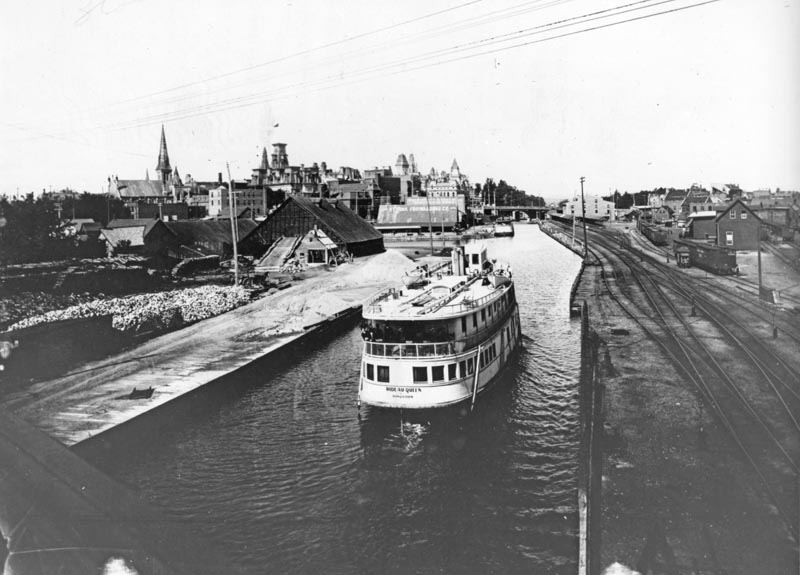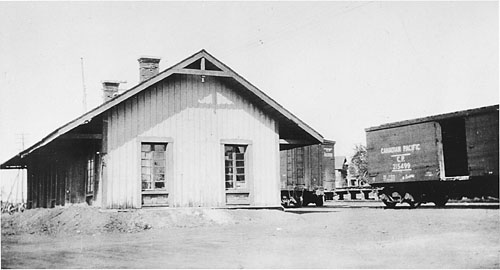| The Bytown and Prescott Railway started running through trains between Bytown and Prescott on December 25 1854. However, the bridge over the Rideau River was not completed until some time in January 1855. Until the bridge was opened a temporary station was used at Montreal Road. No details have been found. |
1895, December 23 - the Canada
Atlantic and
Ottawa, Arnprior and Parry Sound Railways open a temporary passenger
station alongside the Rideau Canal just to the north of Maria
street (later Laurier Avenue). A
special inspection train had been run on Saturday 21 December when
the new station was formally opened. This
photo on the Lost Ottawa Facebook Page shows Canada Atlantic passenger
cars under the old Maria Street wooden bridge, which predates the 1900
Laurier Street bridge over the Canal. It is from the Ottawa City
Archives. There is a baggage-mail car and two open platform passenger
cars, probably the 62-foot long cars. Behind the train is the original
Maria Street temporary station, which was originally erected in 1895 at
the south edge of the turning basin, before the tracks were extended on
pilings across the basin to the Militia Stores building. The Maria
Street station had an operator bay window, which is visible, and three
dormer windows on the west side, and was metal clad, perhaps because of
fire risk from the locomotives. It was later relocated twice, ending up
east of the tracks in the position shown in this view. It may have been
similar in layout to the Canada Atlantic Elgin Street station, with
waiting rooms both sides of the operator bay. The upstairs rooms were
probably offices rather than agent accommodation, which would not have
been needed at this location. There was a second bay projection from
the far end of the station building. The end wall of the first freight
shed is visible beyond the last passenger car. The tall smokestack is
for the original yard office, before it was moved south of Laurier.  From LAC-6895 The former Maria Street temporary station was relocated to become the
freight office, and behind it can be seen the white roof of the then new
freight shed. |
 :LAC PA-6895. This
was taken from the Laurier Bridge. An apparent sister to the
Rideau Queen appears in the background. These boats continued to
serve the Ottawa-Kingston route until the mid 1920's. The
three-storey stone Central Depot/Militia Stores in the centre was
formerly Dufresne & McGarity’s grocery warehouse. All the
passenger station tracks are shown, behind them the switchtender’s
cabin, the former Maria Street temporary station (relocated to become
the freight office), and a glimpse behind it of the white roof of the
new freight shed. The single track at the extreme right
served this shed. The two tracks on light coloured ties in the centre, one with a line of boxcars, are on a trestle over the former turning basin. They had overhead trolley wires for the Ottawa Electric Railway but the wire does not seem to reach the switch near the shanty. This line was originally built in 1896 for OER streetcars to serve Maria Street station, but was not needed as the trains were extended to Central Depot at the same time. A streetcar spur to Central Depot was laid on Besserer Street instead. The 1896 Central Depot has four station tracks visible, on each side of both canopies, plus the canalside track which at this date bypassed the station to reach the 1901 Alexandra bridge. This track was also used to store the Canada Atlantic Railway Montreal trains. The CAR originally used the next two station tracks and the Ottawa Arnprior & Parry Sound Railway used the last two station tracks to the right. By the date of this picture the OA&PS had merged with the CAR but the Montreal & Ottawa (CPR) and Ottawa & New York were also using this station, as well as the Ottawa & Gatineau and Pontiac & Pacific Junction railways from across the river. The last two were soon to be sold to the CPR. However, it may be said that at this date there were effectively six steam and two electric railways here, (including the Hull Electric with their station between Sappers and Dufferin bridges). The canalside and freight tracks had no direct access from the coach yard beyond Laurier Bridge, which was accessible from all four station tracks. The two incoming main lines narrowed to single track under the Laurier Bridge, before spreading out to the station tracks, (shown by a plan dated 1908 in Railway and Marine World, November 1911, page 1011). The photo has only one minor difference from the plan, which gave the first station track an extra crossover to simplify access to more of the coach yard. Other buildings from the left include the first Knox Presbyterian Church, a glimpse of the Mackenzie tower on the West Block, Ottawa City Hall (with the flag), the roof of the Langevin Block, the boxy Russell Theatre/Opera House, the back of the Russell Hotel behind it, the Fire/Police station in front of the theatre, the towers of the East Block and Centre Block (Victoria Tower) behind the corner of the Russell Hotel, the ornate 2nd Empire Post Office, the Parliamentary Library poking up behind it, and the various canal warehouses in front of it. Finally are the arch of Sappers Bridge, the small waiting room and stairs of the Canada Atlantic on the bridge, and Central Depot again. |
 Sussex Street station LAC C-957 |
| On 6 March 1899 the Ottawa and New
York Railway was forced to use a freight building at the St. Patrick Street
bridge as a temporary terminus because
the bridge over the Rideau
River giving access to the Sussex Street depot had become unsafe.
The O&NY was using the CP Sussex Street station until it
could reach agreement to use the Canada Atlantic Central Depot.
O&NY trains began using Central Depot on 20 March 1899. Ottawa Free Press 6 March 1899 Commencing Monday March 6th and until further notice, the trains of the O. & N.Y. Ry will arrive at and leave from St. Patrick street crossing instead of Sussex street depot as heretofore. St. Patrick street cars pass the crossing. The Ottawa and New York railway company is using the freight building at the St. Patrick street bridge for a temporary station, while repairs are being made to the New Edinburgh bridge. Ottawa Journal 6 March 1899 Bridge is Dangerous. Hence Ottawa and New York trains will change their terminus. The Ottawa and New York Railway trains will for the next few weeks leave St. Patrick street bridge instead of the old Sussex Street depot. This has been necessitated owing to the bridge across the Rideau at New Edinburgh being in need of repairs. This bridge has for the past year been considerably out of order and has been patched up in order to keep it in a condition suitable for traffic. It has now become dangerous and the Ottawa and New York Company in order to avoid any danger of accidents have decided to have their terminus at St. Patrick Street bridge until the necessary repairs are completed. O&NY advertisement. Timetable on and after Feb 13, 1899. Shows trains leaving and arriving Ottawa, St. Patrick Street crossing, then Hawthorne. Ottawa Free Press 13 March 1899 The New York and Ottawa Railway company have completed the building of four new piers for the protection of their bridge across the Rideau at New Edinburgh. Ottawa Free Press Saturday 18 March 1899 The Ottawa and New York Railway Company will commence to run passenger trains to and from the Central depot on Monday. No arrangements have yet been made with the C.A.R. in regard to freight trains. |
Canadian Pacific, Broad Street
The
Great Fire of 26-27 April 1900 destroyed the Canadian Pacific
Union Station at Broad Street. Until a new Broad Street station
was opened on 1 December 1900 a temporary station was used, first, a
small office was used, then a tent which was likely later
replaced by a rail car. This picture, PA-135438, from the National Archives, shows the first Canadian Pacific Union Station a day or so after the fire of 26 April 1900. It is taken from Wellington Street, just west of Broad Street, looking towards the Chaudiere. In the foreground are the tracks of the Canada Atlantic Railway, two may have been cleared to restore access to the Chaudiere, where Booth's mill was not destroyed. Trucks of destroyed freight cars are on two of the Canada Atlantic tracks. Behind is the debris from a coal stage of the St. Lawrence and Ottawa, which had a high level unloading track. Behind it is a platform of the St. Lawrence and Ottawa, which appears undamaged. A track of destroyed St. Lawrence and Ottawa freight car trucks is behind. Beyond that are two damaged stone walls which were the partitions in a row of three one-storey storehouses owned by E.B. Eddy, just west of Broad Street. The St. Lawrence and Ottawa and E.B. Eddy site shown here was to be redeveloped over the next few months as the new CPR second Broad Street Union Station. Behind the lumber yard is part of a row of fence posts, a line of trees, and the aqueduct leading to the water works. This is below grade so not visible. Behind the aqueduct is a triangular piece of open ground, widening towards the west at Broad Street. Behind this are the remains of the station platforms, visible as a horizontal line, with ruins of the station building at the right. A tent has been erected as a temporary station, probably on the triangular platform at the north side of the station. The tent was the second temporary station after the fire. On 27 April 1900 "a small office in connection with the roundhouse on the Richmond road was improved as a station" although by 3 May a tent was in use and by 5 May trains were running from the former station site with the tent shown above. There is a crowd on the platform, where a train with two coaches, a baggage-mail-express car and at least four head-end baggage cars is loading.
|
| From 1909 to 1912 the baggage annex on Besserer Street functioned as a temporary station, fitted out with ticket office, waiting room, and even a clock over the entrance, for which there are architectural drawings. |
There is a plan showing a temporary structure that was located near the Rideau River just west of the bridge. The track continued straight for about 400', and at an angle of about 45 degrees to Hurdman Road. The station would have been between the railway and the river, close to Hurdman Road. The station was located about 150' from the end of track on the south side, at Mile 57.40 from Hawkesbury (possibly a drafting error - it should possibly be 56.40.). It is doubtful whether this was ever used as a public station but may have been used for construction purposes prior to the opening to traffic on 5 December 1909 of the Henderson Street or Hurdman station (see below). |
Canadian Northern Ontario, Henderson/Mann Avenues
 The first CNOR train into Ottawa on 5 Dec 1909. LAC C-30310 Canadian Northern Ontario passenger trains commenced using the Grand Trunk Railway Central Station with the opening of services to and from Toronto on 19 August 1914. Trains from Hawkesbury continued to use the Henderson Avenue station until the inauguration of through service between Ottawa and Quebec on August 24. Mixed trains on the line to Pembroke continued to use Henderson Avenue until 8 April 1921. |
| A large number of stations in the Ottawa area were destroyed by fire. A list is shown at: findings3htm#Fire In most cases a temporary station would have been used, usually an old passenger or freight car. |

Updated 6 December 2018